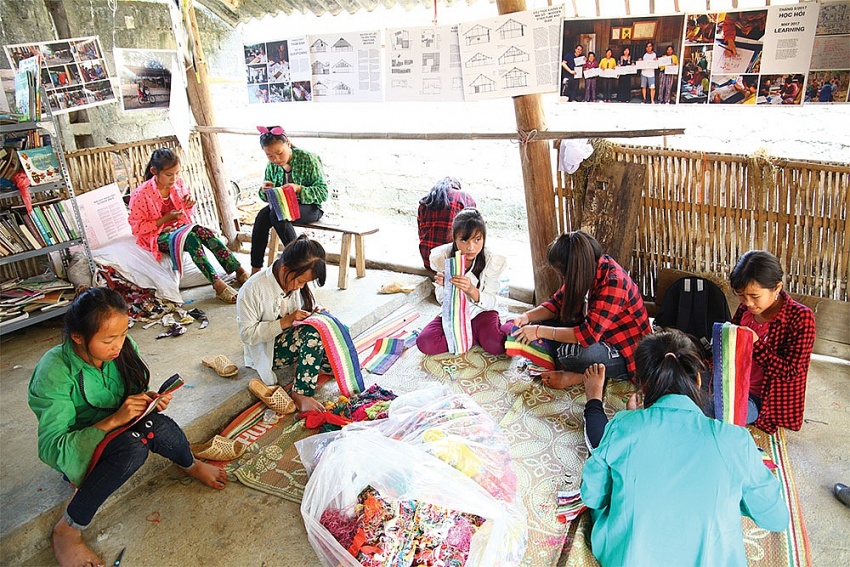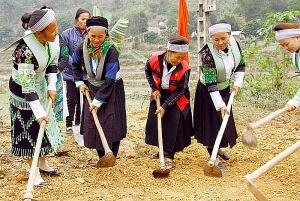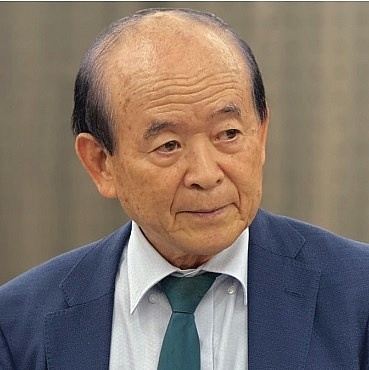Ethnic minorities set for added investment
The Department of International Cooperation under the government’s Committee for Ethnic Minority Affairs (CEMA) and the Institute of International Investment Studies (ISC), last week, signed a cooperation agreement to foster investment in mountainous and remote areas facing massive difficulties.
 |
| Ethnic minorities set for added investment, photo Le Toan |
According to the agreement, the two parties will work together to support mountainous localities to improve the quality and effectiveness of foreign investment cooperation and investment in mountainous provinces.
The CEMA functions as the focal point of the government to manage ethnic affairs throughout the territory of Vietnam. It coordinates with localities to initiate and develop programmes and projects to attract resources to support investment in socioeconomic development in ethnic minority areas, but mainly through capital channels such as official development assistance (ODA) for Vietnam.
“To exploit the great potential and sustainable development of ethnic minority areas, in addition to ODA resources, we need other foreign investment,” said Dr. Hoang Van Xo, general director of the Department of International Cooperation. “The signing of the Memorandum of Cooperation is the basis for implementing activities to support mountainous localities in improving the quality and effectiveness of investment cooperation with foreign countries and promoting investment in mountainous provinces, under the policies of our Party and state.”
According to the plan, in 2024, the department and ISC will cooperate to call projects in two or three provinces.
Implementing the Party and government’s policies on mobilising resources for socioeconomic development in ethnic minority areas, the Department of International Cooperation has promoted and worked with international agencies and organisations at home and abroad, actively supported and coordinated with localities, mobilised and attracted resources such as ODA, and foreign investment and other legal resources, including activities to improve investment in ethnic minority and mountainous provinces.
In late July, Minister-Chairman of the Committee for Ethnic Minorities Affairs Hau A Lenh will lead a delegation to participate in a working trip to Australia, Dr. Xo said. “I am also a member of this trip. The Committee for Ethnic Minorities Affairs will work with the departments of foreign affairs and trade and local authorities in Australia to accelerate the signing of bilateral trade and investment agreement,” he added.
“Before the working trip, we will invite the representative of the Embassy of Australia to Vietnam to work and discuss the pending issues relating to this bilateral agreement to ensure the signing ceremony in Australia goes smoothly.”
The eagerness to bring foreign investment to disadvantaged localities is part of efforts in fostering socioeconomic growth and one of the most important priorities of the government.
Many NA deputies last week focused their discussion on adjustments to the investment policy for the national target programme on socioeconomic development in ethnic minority-inhabited and mountainous areas in 2021-2030.
Vietnam includes 54 ethnic groups, of which the Kinh people account for 85 per cent of the population with 78.32 million people, while the remaining 53 are ethnic minorities, responsible for 14.6 per cent of the country’s population.
The foreign investment inflows in the disadvantaged provinces are modest. The northern midland and mountainous provinces are an example. According to the Foreign Investment Agency under the Ministry of Planning and Investment, by the end of 2023, the northern midlands and mountainous provinces attracted about 1,240 foreign-invested projects with a total registered capital of nearly $29 billion.
With this result, the northern midlands and mountainous regions ranked fifth out of six economic regions of the country in terms of foreign investment attraction and accounted for only 3.4 per cent of the total number of projects; and 6.2 per cent of total foreign direct investment capital invested in Vietnam.
“The statistics indicate that foreign investment in ethnic minority areas is not commensurate with its potential. Restrictions of a soft nature on knowledge, skills, and experience have impacted and adversely affected foreign investment. Thus, we will focus on training legal knowledge, and state management skills on foreign investment and investment promotion operations for officials in mountainous provinces,” said Phan Huu Thang, chairman of the ISC.
Along with the investment promotion activities and development of human resources, NA deputy Truong Xuan Cu representing Hanoi said that investing in education for talented ethnic minority students is one of the crucial missions.
“We can use budget funds or have training contracts with high schools for the gifted under universities in major cities. We will also send qualified individuals and excellent ethnic minority students to study in countries that share borders with their localities to create human resources to contribute to international integration in border provinces,” Cu said.
| Arabella Bennett, second secretary Australian Embassy to Vietnam
Australia is pleased to have supported agricultural development, women’s empowerment, and skills development in Vietnam’s northwest to help contribute to the sustainable, equitable, and inclusive development of this important region. In particular, we are pleased to have worked with ISC and the CEMA, and we are delighted about this exchange. All the issues mentioned at the signing ceremony, including connectivity, infrastructure, and human resources, are crucial. Fostering the development of the mountainous and remoted localities will contribute to the country’s significant progress towards of sustainable development, despite the challenges involved. Hong Sun, chairman Korean Business Association in Vietnam
In the last two weeks, I had a working trip to Soc Trang, Ca Mau, Vinh Long, and Dong Thap provinces to survey the investment situation of South Korean investors, and I saw that there are just a few projects in the agricultural sector. In my role, I will try to organise investment promotion programmes to spread the investment across 63 cities and provinces in the country. During the investment promotion process, it is necessary to consider selecting projects that are suitable for the localities’ natural conditions. For example, we should not attract investment capital in terms of semiconductors and chips in mountainous areas. Instead, we can call high-tech agricultural projects for the northern midlands and mountainous provinces and localities in the western region. The agricultural sector is an advantage of Vietnam, meanwhile, South Korea has developed agriculture, and we have experience and technology, this combination will explore the potential of Vietnam’s agricultural sector to create more added value for local farmers. Furthermore, according to South Korea’s experience, we often develop golf courses and casinos in disadvantaged localities. The gap between the urban area and mountainous areas is too large. In addition, one of the biggest barriers in these areas is the uncompleted transport infrastructure. Thus, the Committee for Ethnic Minorities Affairs should collaborate with the Ministry of Planning and Investment to mobilise aid sources to develop the infrastructure system and the labour forces. Morimoto Yutaka, chairman, Accord Biz
I agree that the mountainous provinces should focus on attracting foreign investment capital in high-tech agriculture to take advantage of the local labour force and favourable natural conditions. Local human resources are a significant factor. In Japan we also have a similar problem with labour shortages in rural areas, especially in mountainous areas, because young people flow to big cities like Tokyo and Osaka to work. The dependence of old people brings Japan barriers to developing high-tech agricultural products. To attract capital in this sector, it is necessary to expand the logistics and infrastructure system and especially expand the markets for export activities. Both foreign investors and local leaders may face difficulties in the early stages of developing high-tech agriculture. However, I believe that it is a feasible idea. It is similar to our first project in Haiphong. My company built Nomura Industrial Park more than 30 years ago, at the time, we faced numerous difficulties in calling investors from Japan because these investors also wanted to pour money into projects in big cities such as Hanoi and Ho Chi Minh City. However, we spent a lot of time convincing them to invest in the northern port city. As a result, now we have a Japanese community in Haiphong. |
 | Ethnic minorities: escaping poverty via credit policies In the past ten years of implementing the preferential credit programme to ethnic minorities, millions of households have been given an opportunity to invest and improve their economic conditions. They have achieved numerous practical results so far, helping to reduce poverty, as well as enhancing overall socioeconomic development and social security in areas home to ethnic minorities or those in great difficulty. |
 | ADB commits $60 million to improve climate infrastructure for ethnic minorities in Vietnam ADB has just approved $60 million to improve the climate resilience of transport and water supply infrastructure in Vietnam’s south-central coastal provinces of Binh Dinh and Quang Nam, especially in remote uplands with large ethnic minority communities. |
What the stars mean:
★ Poor ★ ★ Promising ★★★ Good ★★★★ Very good ★★★★★ Exceptional
Related Contents
Latest News
More News
- Global partnerships key to Vietnam’s IFC development (December 26, 2025 | 16:18)
- Vingroup pulls out of bid to invest in North-South high-speed railway (December 26, 2025 | 11:42)
- Strengthening supply chains through trade promotions and customs reform (December 24, 2025 | 14:00)
- PM orders investment model for North–South high-speed rail (December 22, 2025 | 17:43)
- LS Eco Energy to invest in Vietnam rare earth sector (December 22, 2025 | 17:31)
- Government moves to establish International Financial Centre (December 21, 2025 | 21:00)
- Vietnam's IFC to target global investment flows (December 21, 2025 | 18:00)
- Two national hospitals expand capacity with new facilities (December 20, 2025 | 09:00)
- Ha Tinh breaks ground on major Vingroup industrial and energy projects (December 19, 2025 | 18:24)
- EVN launches major power infrastructure projects nationwide (December 19, 2025 | 18:17)




 Tag:
Tag:





















 Mobile Version
Mobile Version